

TROYAK EXECUTIVE TEAM is informing all members, colleagues, collectors and Polonia at large, that Club meetings taking place at John Paul II Polish Cultural Centre, 4300 Cawthra Rd. (just south of Hwy. 403), Mississauga, Ontario. The new members are always welcome. www.polishculturalcentre.ca
ADRES SPOTKAÑ KLUBOWYCH ! Zarząd Główny Klubu “Troyak” informuje wszystkich członków kolekcjonerów, sympatyków oraz całą Polonię, że spotkania klubowe odbywają się w Polskim Centrum Kultury im. Jana Pawła II, przy 4300 Cawthra Rd. (na południe od autostrady 403), Mississauga, Ontario. Zapraszamy nowych członków do prężnego. Klubu “Troyak”. www.polishculturalcentre.ca

“TROYAK” CLUB NEXT MEETINGS …
NASTĘPNE SPOTKANIA KLUBU “TROYAK” …
24th February 2019 @ 4:30 p.m.
3rd March 2019 …
XVI Polish – Canadian Coin, Stamp & Collectibles Show 2019
31st March 2019 @ 4:30 p.m.
28th April 2019; 26th May 2019; 23rd June 2019
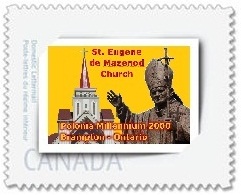
July & August 2019 – Summer break … Letnie wakacje …
29th September 2019
6th October 2019 @ 9:00 a.m. to 4:00 p.m. …
Mississauga’s Coin & Stamp Show 2019
27th October 2019; 24th November 2019
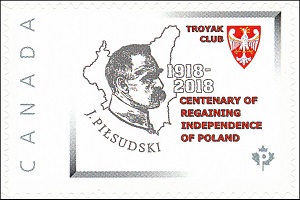
Sunday, MARCH 3, 2019, Mississauga, Ontario
XVI Polish – Canadian Coin, Stamp & Collectibles Show 2019
at John Paul II Polish Cultural Centre
4300 Cawthra Rd. (just south of Hwy. 403). Mississauga, Ontario.
SUNDAY 9 am to 4 pm with $5 adult admission.
Kids 16 and under Free. Free parking.
30+ DEALERS of CANADIAN and INTERNATIONAL Stamps, Gold and Silver Coins,
Royal Canadian Mint Coins, Paper Money, Military and other Collectibles.
Bring coins, stamps or collectibles to be evaluated and get best prices.
Organized by the Polish-Canadian Coin & Stamp Club (Troyak Club) …
offering free stamps for kids.
and Club Members. See www.troyakclub.com for details.
More information: Contact Les Plonka – leszekp@rogers.com
or call (416) 505-7999 …


Special Medal by Consulate of Poland & Troyak Club
www.troyakclub.com
The idea to issue a medal for the 100th anniversary of Poland regaining its Independence started several months ago. The Consulate General of Poland in Toronto was approached to see if they would like to sponsor such medal. They agreed to cover the costs of the dies and the design. The designer, Dorothy Baniak, undertook the challenge to design a Polish-Canadian themed medal. It took a few tries to become what it is now. Medal will be struck in silver and copper. The medal will be ready for distribution in February/March 2019 timeframe. Email info@troyakclub.com for information on ordering the medal, stamps or covers.
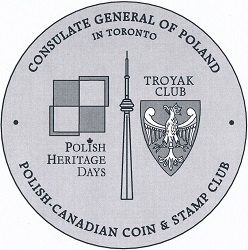
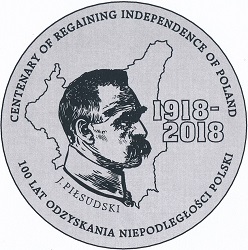
Final design of the Medal. Designer: Dorothy Baniak …
“DESIGN-Consulate-Troyak SIDE” & “DESIGN-PILSUDSKI SIDE”.
Medal specifications: Silver: 0.9999 Fine Silver 1 oz. in plastic capsule.
Copper: Alloy #110 Copper in a plastic capsule.
Size: 3.30 mm x 38.00 mm dia.
Non-Member Cost: Silver $70 CAD; Copper $15 CAD.

Żołnierze Niepodległości
Independence Soldiers
www.poczta-polska.pl
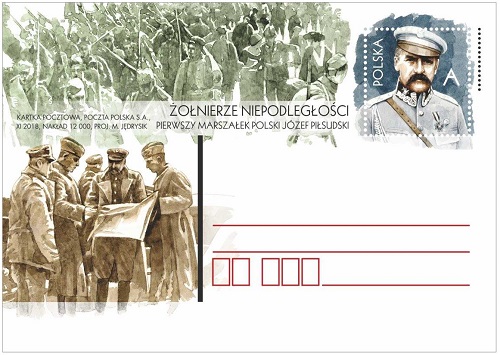
Dnia 11 listopada 2018 r. zostały wprowadzone do obiegu kartki pocztowe z nadrukowanym znakiem opłaty pocztowej, emisji: Żołnierze Niepodległości. Przedstawiają one wizerunki marszałka Polski Józefa Piłsudskiego; generała broni Józefa Dowbora-Muśnickiego; generała broni Józefa Hallera; generała broni Stanisława Szeptyckiego; generała broni Tadeusza Jordana-Rozwadowskiego. Wartość nominalna znaku opłaty pocztowej z oznaczeniem literowym A odpowiada wartości nominalnej znaczka pocztowego używanego do uiszczenia opłaty za ekonomiczną przesyłkę listową nierejestrowaną, w tym kartkę pocztową, w obrocie krajowym, o masie do 350 g.

W prawym górnym rogu strony adresowej każdej z kartek nadrukowano znak opłaty pocztowej, na którym przedstawiono: *1) na pierwszym znaku – podobiznę pierwszego Marszałka Polski Józefa Piłsudskiego; wzdłuż lewej krawędzi znaczka umieszczono napis: POLSKA, a w środkowej części prawej krawędzi – oznaczenie wartości: A, *2) na drugim znaku – podobiznę generała broni Józefa Dowbora-Muśnickiego; w prawym górnym rogu znaczka umieszczono oznaczenie wartości: A, a wzdłuż prawej krawędzi – napis: POLSKA, *3) na trzecim znaku – podobiznę generała broni Józefa Hallera; wzdłuż lewej krawędzi znaczka umieszczono napis: POLSKA, a w lewym górnym rogu – oznaczenie wartości: A, *4) na czwartym znaku – podobiznę generała dywizji Stanisława Hallera; wzdłuż lewej krawędzi znaczka umieszczono napis: POLSKA, a w prawym górnym rogu – oznaczenie wartości: A, *5) na piątym znaku – podobiznę generała broni Stanisława Szeptyckiego; w prawym górnym rogu znaczka umieszczono oznaczenie wartości: A, a wzdłuż prawej krawędzi – napis: POLSKA. *6) na szóstym znaku – podobiznę generała broni Tadeusza Jordana-Rozwadowskiego; w prawym dolnym rogu znaczka umieszczono oznaczenie wartości: A, a wzdłuż prawej krawędzi – napis: POLSKA.
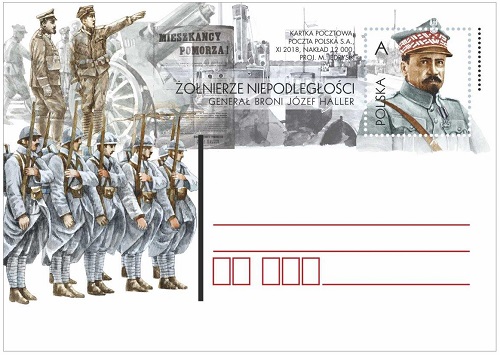
Wartość: A … autor projektów kartek: M. Jędrysik;
liczba znaczków: 6; nakład: po 12 000 szt.;
technika druku: offset; format kartek: 148 x 105 mm;
data wprowadzenia do obiegu: 11 listopada 2018 r.
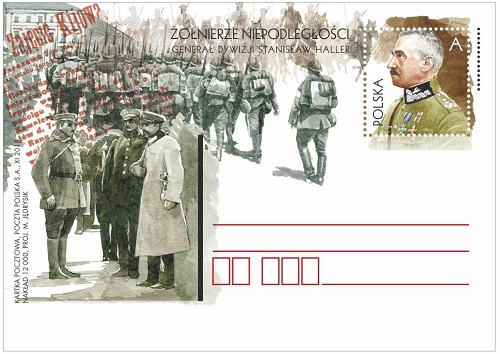
Independence Soldiers … denomination: 2,60 PLN;
number of stationeries in set: 6; print run: 12.000 pcs;
printing technique: offset; card size: 148 x 105 mm;
author: Maciej Jędrysik; release date: 11th November 2018.
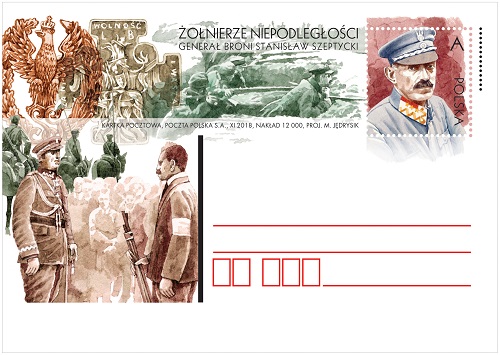
W części ilustracyjnej kartek umieszczono: *1) na pierwszej kartce – ochotników w marszu na front podwarszawski, nazwę emisji: ŻOŁNIERZE NIEPODLEGŁOŚCI, napis: PIERWSZY MARSZAŁEK POLSKI JÓZEF PIŁSUDSKI, Józefa Piłsudskiego z oficerami nad mapą, z prawej generał Edward Śmigły-Rydz, *2) na drugiej kartce – wezwanie ,,DO BRONI” wystosowane przez dowództwo wojsk wielkopolskich do mieszkańców Ostrowa Wielkopolskiego i Krotoszyna, nazwę emisji: ŻOŁNIERZE NIEPODLEGŁOŚCI, napis: GENERAŁ BRONI JÓZEF DOWBOR-MUŚNICKI, defiladę oddziału piechoty wielkopolskiej oraz żołnierzy w okopach na froncie, *3) na trzeciej kartce – generała Józefa Hallera na pierwszej linii frontu, w tle działon artylerii, odezwa generała Józefa Hallera do mieszkańców Pomorza z okazji powrotu ziem północnych do Macierzy i zaślubin Polski z morzem w Pucku, pierwsze okręty polskiej Marynarki Wojennej, nazwę emisji: ŻOŁNIERZE NIEPODLEGŁOŚCI, napis: GENERAŁ BRONI JÓZEF HALLER, dwuszereg żołnierzy ,,Błękitnej Armii”, *4) na czwartej kartce – notatkę z Kuriera Warszawskiego o zajęciu Kijowa, oddział jazdy, nazwę emisji: ŻOŁNIERZE NIEPODLEGŁOŚCI, napis: GENERAŁ DYWIZJI STANISŁAW HALLER, przemarsz wojsk polskich przez Kijów 9 maja 1920 r., generała Stanisława Hallera składającego meldunek Józefowi Piłsudskiemu,

*5) na piątej kartce – odznakę oficera Sztabu Generalnego, odznakę Dywizji Litewsko-Białoruskiej ,,ZA NASZĄ WOLNOŚĆ I WASZĄ 1919″, nazwę emisji: ŻOŁNIERZE NIEPODLEGŁOŚCI, napis: GENERAŁ BRONI STANISŁAW SZEPTYCKI, żołnierzy w okopach na froncie północno-wschodnim, generała Stanisława Szeptyckiego na Śląsku podczas uroczystości powrotu Ziemi Pszczyńskiej do Polski w czerwcu 1922 r., *6) na szóstej kartce – samolot myśliwski Albatros z godłem VII Eskadry Bojowej im. Tadeusza Kościuszki, w której walczyli piloci amerykańscy, poniżej jeden z ochotników amerykańskich Merian C. Cooper, grupę ,,straceńców” po zdobyciu ratusza we Lwowie, komunikat rządowy z 16 sierpnia 1920 r. o pierwszych sukcesach na froncie, nazwę emisji: ŻOŁNIERZE NIEPODLEGŁOŚCI, napis: GENERAŁ BRONI TADEUSZ JORDAN-ROZWADOWSKI, generała Tadeusza Jordana-Rozwadowskiego, studiującego sytuację z oficerami sztabu. Kartki o wymiarach 148 x 105 mm wydrukowano jednostronnie, techniką offsetową, na kartonie białym, w nakładzie po 12 000 sztuk. Autor projektów kartek: Maciej Jędrysik.

100. rocznica odzyskania przez Polskę niepodległości
100th anniversary of Poland’s regaining independence
www.poczta-polska.pl

Wartość: każdy po 2,60 zł … liczba znaczków: 8;
autorka projektu znaczków: Marzanna Dąbrowska;
autor koloryzacji fotografii: Mirosław Szponar;
nakład: każdego po 180 000 szt.; papier: fluorescencyjny;
technika druku znaczków: offset + raster stochastyczny;
format znaczka: 31,25 x 43 mm; arkusz sprzedażny: 8 znaczków
+ przywieszka z dynamicznym efektem optycznym;
data wprowadzenia do obiegu: 11 listopada 2018 r.

100th anniversary of Poland’s regaining independence …
denomination: 2,60 PLN; printing technique: offset and stochastic raster;
number of stamps in set: 8 (8 stamps with label with dynamic optical effect in sheet);
print run: 180.000 pcs; stamp size: 31,25 x 43 mm; author: Marzanna Dąbrowska;
author coloration of photographs: Mirosław Szponar;
release date: 11th November 2018.
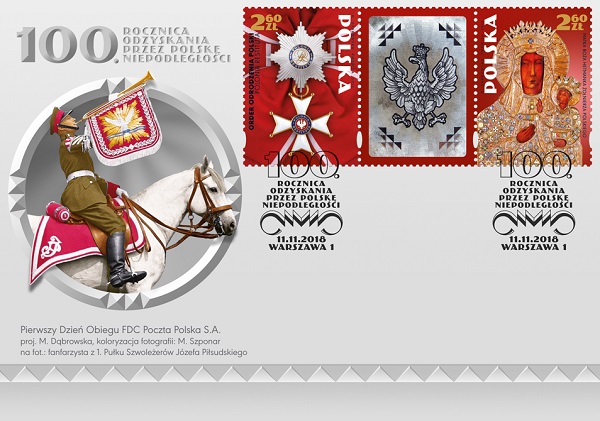
W dniu 11 listopada 2018 r. zostały wprowadzone do obiegu znaczki pocztowe o wartości 2,60 zł emisji “100. rocznica odzyskania przez Polskę niepodległości”. Na poszczególnych znaczkach przedstawiono: *1) na pierwszym – Ignacego Jana Paderewskiego; wzdłuż lewej krawędzi znaczka umieszczono napis: Ignacy Jan Paderewski 1860-1941, wzdłuż prawej krawędzi – napis POLSKA, a w lewym górnym rogu – oznaczenie wartości 2,60 ZŁ; *2) na drugim – Józefa Piłsudskiego; wzdłuż lewej krawędzi znaczka umieszczono napis: POLSKA, wzdłuż prawej krawędzi – napis Józef Piłsudski 1867-1935, a w prawym górnym rogu – oznaczenie wartości 2,60 ZŁ; *3) na trzecim – Romana Dmowskiego; wzdłuż lewej krawędzi znaczka umieszczono napis: POLSKA, wzdłuż prawej krawędzi – napis Roman Dmowski 1864-1939, a w prawym górnym rogu – oznaczenie wartości 2,60 ZŁ; *4) na czwartym – Order Odrodzenia Polski; wzdłuż lewej krawędzi znaczka umieszczono napis: ORDER ODRODZENIA POLSKI POLONIA RESTITUTA, wzdłuż prawej krawędzi – napis POLSKA, a w lewym górnym rogu – oznaczenie wartości 2,60 ZŁ; *5) na piątym – wizerunek Matki Bożej Hetmanki Żołnierza Polskiego; wzdłuż lewej krawędzi znaczka umieszczono napis: POLSKA, wzdłuż prawej krawędzi – napis MATKA BOŻA HETMANKA ŻOŁNIERZA POLSKIEGO, a w prawym górnym rogu – oznaczenie wartości 2,60 ZŁ; *6) na szóstym – Wincentego Witosa; wzdłuż lewej krawędzi znaczka umieszczono napis: Wincenty Witos 1874-1945, wzdłuż prawej krawędzi – napis POLSKA, a w lewym górnym rogu – oznaczenie wartości 2,60 ZŁ; *7) na siódmym – Ignacego Daszyńskiego; wzdłuż lewej krawędzi znaczka umieszczono napis: POLSKA, wzdłuż prawej krawędzi – napis Ignacy Daszyński 1866-1936, a w prawym górnym rogu – oznaczenie wartości 2,60 ZŁ; *8) na ósmym – Wojciecha Korfantego; wzdłuż lewej krawędzi znaczka umieszczono napis: POLSKA, wzdłuż prawej krawędzi – napis Wojciech Korfanty 1873-1939, a w prawym górnym rogu – oznaczenie wartości 2,60 ZŁ. Z tej okazji zostały wydane trzy koperty FDC.
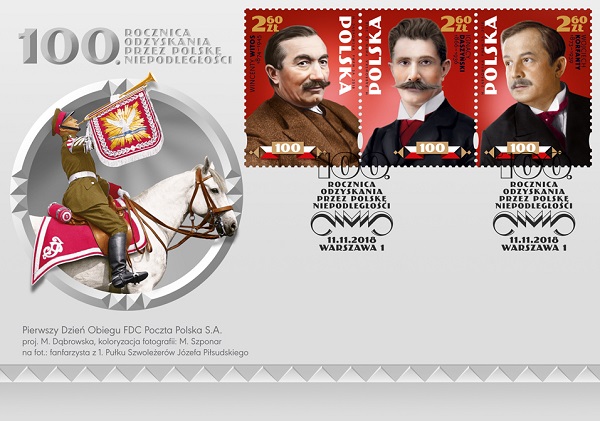

100. rocznica zakończenia I wojny światowej
100th anniversary of the end of the First World War
www.poczta-polska.pl
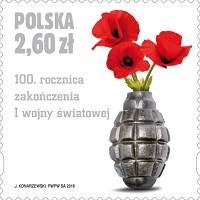
Znaczek „100. rocznica zakończenia I wojny światowej” przedstawia wazon z makami, które stanowią międzynarodowy symbol zakończenia tej wojny. Wazon to francuski granat F1 wykorzystywany podczas I wojny światowej. Autorem projektu znaczka Jan Konarzewski. – Poczta Polska dokłada wszelkich starań, by w swojej działalności filatelistycznej upamiętniać najważniejsze wydarzenia historyczne oraz wspierać tworzenie pomostu pomiędzy pokoleniami, narodami i kulturami – mówi Wiesław Włodek, wiceprezes Zarządu Poczty Polskiej.

Wartość: 2,60 zł … autor projektu: Jan Konarzewski;
liczba znaczków: 1; nakład: 135 tys. szt.; technika druku: offset;
format znaczka: 40,5 x 40,5 mm; arkusze sprzedażne: 9 znaczków;
papier: fluorescencyjny; data wprowadzenia do obiegu: 11 listopada 2018 r.
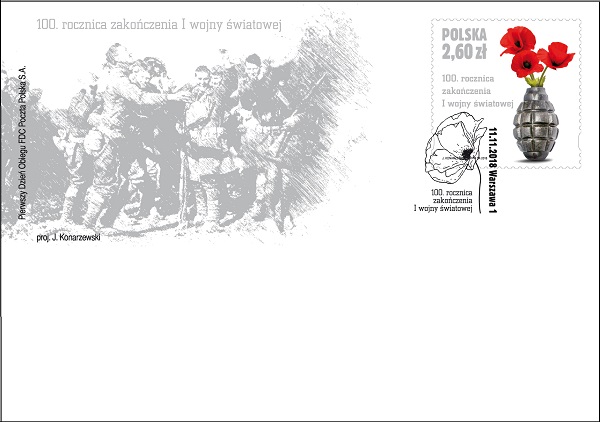
100th anniversary of the end of the First World War …
denomination: 2,60 PLN; number of stamps in set: 1; print run: 135.000 pcs;
printing technique: offset; stamp size: 40,5 x 40,5 mm;
author: Jan Konarzewski; release date: 11th November 2018.

100. rocznica wybuchu Powstania Wielkopolskiego
www.nbp.pl
Narodowy Bank Polski ma wyłączne prawo emitowania znaków pieniężnych Rzeczypospolitej Polskiej, w tym monet i banknotów kolekcjonerskich. Wszystkie monety i banknoty emitowane przez NBP są prawnym środkiem płatniczym w Polsce. 12 grudnia 2018 roku Narodowy Bank Polski wprowadził do obiegu srebrną monetę o nominale 10 zł oraz złotą monetę o nominale 200 zł „100. rocznica wybuchu Powstania Wielkopolskiego”.
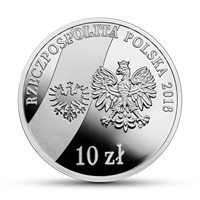
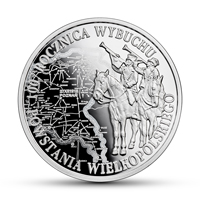
Nominał: 10 zł … Metal: Ag 925/1000; Stempel: lustrzany;
Średnica: 32,00 mm; Masa: 14,14 g; Brzeg (bok): gładki;
Nakład: do 15 000 szt.; Projektant: Dobrochna Surajewska;
Data emisji: 12 grudnia 2018 r.; Emitent: NBP;
Na zlecenie NBP monety wyprodukowała Mennica Polska S.A.
Wizerunek ułanów z okresu Powstania Wielkopolskiego,
wg fotografii pochodzącej ze zbiorów Muzeum Początków
Państwa Polskiego w Gnieźnie.
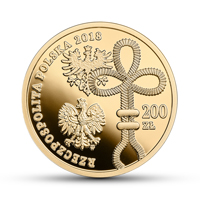
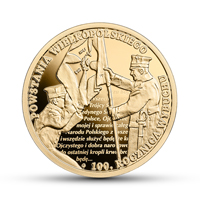
Nominał: 200 zł … Metal: Au 900/1000; Stempel: lustrzany;
Średnica: 27,00 mm; Masa: 15,50 g; Brzeg (bok): gładki;
Nakład: do 1 500 szt.; Projektant: Grzegorz Pfeifer;
Data emisji: 12 grudnia 2018 r.; Emitent: NBP;
Na zlecenie NBP monety wyprodukowała Mennica Polska S.A.
Wizerunki przedstawione na rewersie, wg. fotografii
„Zaprzysiężenie wojsk wielkopolskich 26.01.1919 r.
– Poznań Pl. Wolności”, pochodzącej ze zbiorów Wielkopolskiego
Muzeum Niepodległości w Poznaniu.
100. rocznica wybuchu Powstania Wielkopolskiego … 11 listopada 1918 roku kończy się I wojna światowa. Mimo kapitulacji Niemiec Wielkopolska nadal jest pod zaborem, a o jej przyszłości ma rozstrzygnąć konferencja pokojowa. Anarchia w armii niemieckiej i wybuch rewolucji w Rzeszy sprzyjają jednak walce o niepodległość. W Poznaniu powstaje złożona z Polaków Rada Robotnicza oraz Tymczasowa Naczelna Rada Ludowa i kierujący nią Komisariat. 13 listopada Polacy przejmują kontrolę nad niemiecką Radą Żołnierską. 3 grudnia w Poznaniu zbiera się Sejm Dzielnicowy − parlament reprezentujący Polaków zamieszkujących ziemie pozostające w granicach Niemiec. Przemarsz jego delegatów staje się preludium do insurekcji. 26 grudnia 1918 roku do Poznania przybywa entuzjastycznie witany Ignacy Jan Paderewski. Nazajutrz, 27 grudnia pod Hotelem Bazar gromadzą się tłumy Polaków. Niemieccy cywile i żołnierze organizują kontrmanifestacje, niszczą polskie lokale i zrywają alianckie flagi. Pod gmachem Prezydium Policji dochodzi do wymiany ognia, podczas której giną pierwsi powstańcy. Tak rozpoczyna się powstanie. Jego dowódcą zostaje major Stanisław Taczak, który koordynuje walki wybuchające w Wielkopolsce.
Od połowy stycznia 1919 roku komendę przejmuje gen. Józef Dowbor-Muśnicki. Tworzy Armię Wielkopolską, charakterystycznie umundurowaną, z wysokimi czapkami, orłami wielkopolskimi i oznakami stopni wojskowych w kształcie trefli. Teren walk rozciąga się od Kępna na południu, przez Międzychód na zachodzie, po rzekę Noteć na północy oraz dawną granicę niemiecko-rosyjską na wschodzie. 16 lutego 1919 roku w Trewirze zostaje podpisany rozejm. Armię Wielkopolską uznaje się za wojsko sprzymierzone, a zajęte przez powstańców tereny na mocy traktatu wersalskiego zostają włączone do państwa polskiego. Powstańcy wielkopolscy bezpośrednio z frontu przechodzą do walki o Lwów, uczestniczą w wojnie z bolszewikami oraz III powstaniu śląskim. Po raz kolejny przyczyniają się do realizacji wielkiego celu – ustalenia granic odradzającej się Rzeczypospolitej. Na rewersie srebrnej monety przedstawiono trębaczy z orkiestry 3. Pułku Ułanów Wielkopolskich na tle mapy z zaznaczonym przebiegiem powstania. Na awersie stylizowany orzeł powstańczy i współczesne godło.
Na rewersie złotej monety gen. Józef Dowbor-Muśnicki, głównodowodzący Polskich Sił Zbrojnych byłego zaboru pruskiego, wręcza sztandar gen. Filipowi Dubiskiemu, dowódcy 1. Dywizji Strzelców Wielkopolskich. W tle widać fragment tekstu przysięgi Wojsk Wielkopolskich, złożonej 26 stycznia 1919 roku w Poznaniu. Na awersie orzeł powstańczy obok współczesnego godła. Z prawej strony umieszczono trefl z czapki generalskiej. Informacja: Robert Gaweł, senator RP.

100th Anniversary of the Outbreak of the Wielkopolskie Uprising
www.nbp.pl
Narodowy Bank Polski holds the exclusive right to issue the currency of the Republic of Poland, including collector coins and banknotes. All coins and banknotes issued by NBP are legal tenders in Poland. All Polish coins feature: face value, the image of the Eagle established as the state emblem of the Republic of Poland inscription: Rzeczpospolita. On 12 December 2018, Narodowy Bank Polski issued into circulation a silver collector coin with a face value of 10 zł and a gold collector coin with a face value of 200 zł – “100th Anniversary of the Greater Poland Uprising”.


Face value: 10 zł … Metal: Ag 925/1000; Finish: proof;
Dimensions: 32.00 mm; Weight: 14.14 g; Edge (side): plain;
Mintage: up to 15,000 pcs; Designer: Dobrochna Surajewska;
Date of issue: 12 December 2018; Issuer: NBP;
The coins, commissioned by NBP, were struck by Mennica Polska S.A.
Image of uhlans from the period of the Greater Poland Uprising
according to a photo from the collection of the Museum
of the Origins of the Polish State in Gniezno.


Face value: 200 zł … Metal: Au 900/1000; Finish: proof;
Diameter: 27.00 mm; Weight: 15.50 g; Edge (side): plain;
Mintage: up to 1,500 pcs; Designer: Grzegorz Pfeifer;
Date of issue: 12 December 2018; Issuer: NBP;
The coins, commissioned by NBP, were struck by Mennica Polska S.A.
Images on the reverse, according to the photo entitled
“The Swearing-in of the Greater Polish Army at Wolności Square
in Poznań on 26 January 1919”, from the collection of the Independence
Museum of the Greater Poland Province in Poznań.
100th Anniversary of the Outbreak of the Greater Poland Uprising … 11 November 1918 brought the end of World War I. Despite Germany’s capitulation, the province of Greater Poland was still under occupation and its future was to be decided at a peace conference. However, the anarchy in the German army and the outbreak of the German revolution created favourable conditions for the armed struggle for the incorporation of Greater Poland into the Polish state. In Poznań Poles set up a Workers’ Council and a Supreme People’s Council headed by a Commissariat, while on 13 November they took over the German-dominated Soldiers’ Council. On 3 December the Sejm of the province convened in Poznań. It was a parliament representing those Poles who still remained within German borders and the march of its delegates became a prelude to the uprising.
On 26 December 1918 Ignacy Jan Paderewski arrived in Poznań to an enthusiastic welcome. The following day Polish crowds gathered in front of the place he stayed in, the Bazar Hotel. German soldiers and civilians reacted by organizing counter-manifestations, vandalising Polish premises and tearing down Allied flags. An exchange of fire took place in front of the Police Headquarters, and the first fatalities were recorded. This is how the uprising began, with Major Stanisław Taczak becoming its commander and taking charge of coordinating the fighting in the whole of Greater Poland. In mid-January 1919 the command was transferred to General Józef Dowbor-Muśnicki. He created the Greater Polish Army, with its distinct uniforms, high caps, eagles and characteristic club-shaped rank distinctions. Fighting engulfed the territory between Kępno in the south, Międzychód in the west, the Noteć river in the north and the former Russo-German border in the east.
Truce was signed on 16 February 1919 in Trier. Pursuant to the Treaty of Versailles, the Greater Polish Army was recognised as an Allied formation and the territory occupied by the insurrectionists was incorporated into the Polish state. Having returned from the front, the Greater Poland insurrectionists moved immediately to other theatres of war, participating in the fight for Lwów, the war with the Bolsheviks and the 3rd Silesian Uprising. Thus they contributed to the establishment of the frontiers of the Second Polish Republic. The reverse of the silver coin depicts trumpeters from the orchestra of the Third Greater Poland Uhlans Regiment against the map illustrating the shifting frontlines. The obverse features a stylised eagle adopted as an emblem by the insurrectionists next to the present-day Eagle established as the emblem of the Polish state. On the reverse of the gold coin General Józef Dowbor-Muśnicki, Commander- in-Chief of the Polish Armed Forces of the former Prussian Partition, hands a banner to General Filip Dubiski, commander of the 1st Division of Greater Poland Rifles. In the background, there is a fragment of the text of the oath taken by the Greater Polish Army on 26 January 1919 in Poznań. The obverse features the eagle adopted as an emblem by the insurrectionists next to the present-day Eagle established as the emblem of the Polish state. On the right, there is a club-shaped distinction from a general’s cap. Info: Robert Gaweł, senator of the Republic of Poland.


LOUIS RIEL (1844 – 1885) … On Canadian Stamps
www.collectionscanada.gc.ca/postal-archives/080608_e.html
www.canadapost.ca
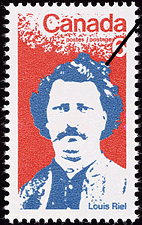
Louis Riel … Denomination: 6¢; Date of Issue: 19 June 1970;
Printer/Quantity: British American Bank Note Company /37 000 000;
Perforation: 12.5 x 12; Creator: Designed by Reinhard Derreth;
Based on a photograph by William James Topley.
Historical Notice: The commemoration of Louis Riel occurs during the year which is widely recognized as the one hundredth anniversary of the apex of his career. The offspring of a respected family whose roots were deep in the Red River country, Riel, referred to by historians as one of the decisive figures in Canada’s formative years, was an articulate and intelligent but enigmatic figure endowed with a deep sense of “mission”. Although some have place his birth date as 1847, by his own account he was born at St. Boniface on the 23rd October 1844, the son of Louis Riel, a Métis, and Julie de Lagemaundière, the daughter of the first white woman in the North West. Beginning in 1858 he spend several years in Montreal attending a college to which he had been sent by Bishop Taché of St. Boniface. The influx of settlers from eastern areas of the country into what was to eventually become the provinces of Manitoba and Saskatchewan provoked opposition among the predominantly métis populations, first in the Red River Rising of 1869-70 and later in the North West Rebellion in 1885. In the first instance, the Government of Canada and the Government of Great Britain were negotiating transfer of western territories from the Hudson’s Bay Company to the control of the Canadian Government.
In an administrative vacuum to which transitional events had contributed, Louis Riel accepted his role as leader among his people and became head of the Council of Assiniboia. It is clear that the métis regarded the negotiations for transfer of the area as a threat to their established customs, rights, land titles and to the very fabric of their society. Riel and his people insisted upon their right to be heard and pressed upon the Government of Canada the principle of consultation before annexation. The procedure to which they subscribed subsequently proved to be fundamental to the Canadian Federal System. In the Red River Rising, the advance of military forces sent by the Canadian Government jeopardized Riel’s safety and ended his temporary control of Fort Garry. But this was not to be the end of his leadership in the Métis’ cause.
Intervening years saw his election to the Federal Parliament, from which he was eventually expelled. In 1884 he returned to Canada from the United States to lead his people who considered their new settlement on the banks of the North Saskatchewan River endangered by the continuing advance of agricultural settlers and the construction of a railway from the east. Armed rebellion in this instance brought swift reaction from the Canadian Government and the newly constructed railway meant forces could be quickly transported to the “end of steel” at Regina. Sharp and bitter clashes ensued but in the end Riel became a prisoner of the Government forces whose leader General Middleton was then able to make terms with the rebellions faction. Riels’ turbulent life ended on a scaffold at Regina on 16th November 1885. He had been tried and convicted in the same city on a charge of treason.
More history … During the late 19th century, when pioneers moved into the prairie farmlands claimed by the Métis, a leader arose to defend the rights of these half-French and half-Indian nomadic people. His name was Louis Riel. Riel became prominent during the Red River Rebellion of 1869-70, which led to the creation of the province of Manitoba and which caused the Métis to move farther west to the Saskatchewan River Valley. There they stayed until the 1880’s when the coming of the railroad threatened to bring still more settlers to the land. To protect their rights the Métis petitioned Ottawa, but their demands were ignored. In March of 1885 they joined forces with the Cree and Assiniboin Indians and called upon Riel to lead a second uprising, the North West Rebellion. This abortive war ended in defeat for Riel and his followers, and on November 16, 1885 Riel was hanged for high treason. (38-II-19)

$1 White tailed deer and Atlantic walrus – Pane of 16
www.canadapost.ca
The $1 definitives feature engravings of two animals indigenous to Canada, the white-tailed deer and the Atlantic walrus. The two stamps are printed on both intaglio and offset presses, with background colours in lithography, so colour is a big part of what’s new.
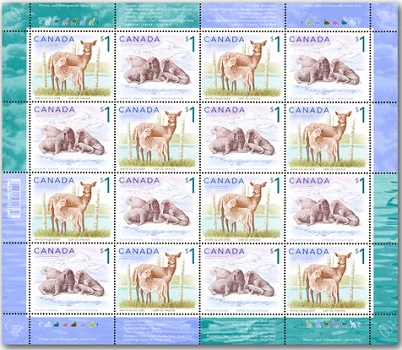
Denomination: 2 x 1.00; Design: Parable Communications;
Gum type: P.V.A.; Atlantic walrus: Pierre Leduc; Jorge Peral;
Illustration: White-tailed deer: Xerxes Irani; Jorge Peral;
Paper type: Tullis Russell Coatings; Perforations: 13+;
Photography: Jack Hollingsworth; James Gritz
Printer: Canadian Bank Note; Tagging: General, 4 sides;
Printing process: Lithography in 6 special colours plus
steel engraving in 3 colours.

Kiosk Stamps
www.canadapost.ca

Take advantage of a limited-time opportunity to purchase this Official First Day cover featuring five domestic stamps previously available only at print-on-demand kiosks in select Canada Post retail locations. Each stamp features a landscape painting by one of five Canadian artists, including members of the renowned Group of Seven and their contemporaries. The selected works are Indian War Canoe (Alert Bay) by Emily Carr, Little Haven, Nova Scotia by Arthur Lismer, The Front of Winter by James Edward Hervey MacDonald, Winter, Baie-Saint-Paul by Albert Henry Robinson, and In The Northland by Tom Thomson. All five paintings are from the collection of the Montreal Museum of Fine Arts. The stamps are designed by Stéphane Huot and printed on Avery Dennison Paper. The denomination and numeric code are printed by direct thermal print. The cancel location is Vancouver, British Columbia.


2019 … $15 Pure Silver Coin – Lunar Lotus: Year of the Pig
www.canadapost.ca www.mint.ca
A peace-loving soul with a heart of purest gold—in pure silver! According to the Chinese zodiac, 2019 is the Year of the Pig, celebrating a resourceful creature known for being observant, intelligent, and confident. Playful and loyal, the Pig will always stay by your side. Crafted in the Royal Canadian Mint’s exceptional 99.99% pure silver with a beautiful proof finish, the coin features a stylized pig design over a mirror background. Gorgeous packaging! Your coin is housed in a silver satin-like case wrapped in a custom red sleeve. A beautiful display! A stunning gift to celebrate a birth, birthday, or special event. Lucky mintage of 15,888 coins!

Face value: 15 dollars … Composition: 99.99% Pure Silver;
Mintage: 15,888; Weight: 26.7 g; Diameter: 38 mm; Edge: Plain;
Finish: Proof; Artist: Three Degrees Creative Group;
Packaging: Silver satin-like covered case with a custom red sleeve.
In the Chinese lunar calendar, the year 2019 is ruled by the Pig—a true diamond in the rough! The Pig also ruled 1911, 1923, 1935, 1947, 1959, 1971, 1983, 1995, and 2007. Though it may appear unrefined, the down-to-earth pig personality is associated with kindness and loyalty. An excellent listener, the pig will always support you. And if you’re wrong, he or she won’t have the heart to tell you. A lover of the good things in life who rarely holds a grudge, this peace-loving soul wants everyone to get along. On this coin, the friendly pig frolics among the lucky blossoms, ensconced within the unique scallop edging of our famed annual Lunar Series!
Design: Designed by Three Degrees Creative, this scallop-edged coin offers a pleasing profile portrait of the smiling Pig. This depiction highlights the animal’s traditional character and associations in Chinese astrology: friendship, courage, confidence, and resourcefulness. In this treatment, the happy-go-lucky Pig is surrounded by a semi-circle of lovely good-luck blossoms. In the polished field above the central image is the Chinese character for “pig.”

2019 … $15 Pure Silver Coin – Year of the Pig
www.canadapost.ca www.mint.ca
Here’s to loyal friends and peace lovers! According to the Chinese zodiac, 2019 is the Year of the happy-go-lucky Pig, a resourceful creature known for being observant, intelligent, and confident. Playful and loyal, the Pig will always stay by your side. Celebrate the Year of the Pig with this whimsical silver coin! Makes a beautiful gift. The Year of the Pig also ruled 1911, 1923, 1935, 1947, 1959, 1971, 1983, 1995, and 2007. Artist Aries Cheung’s reverse design captures the spirit of the friendly, resourceful, and courageous pig. A lucky mintage of 15,888 coins!

Face value: 15 dollars … Composition: 99.99% Pure Silver;
Mintage: 15,888; Weight: 31.39 g; Diameter: 38 mm;
Finish: Proof; Edge: Serrated; Artist: Aries Cheung;
Packaging: Silver satin-like covered case with a custom red sleeve.
According to the Chinese zodiac, 2019 is the Year of the happy-go-lucky Pig, a resourceful creature known for being observant, intelligent, and confident. Playful and loyal, the Pig will always stay by your side. In the Chinese lunar calendar, the year 2019 is ruled by the Pig—a true diamond in the rough! The Pig also ruled 1911, 1923, 1935, 1947, 1959, 1971, 1983, 1995, and 2007. Though it may appear unrefined, the down-to-earth Pig personality is associated with kindness and loyalty. An excellent listener, the Pig will always support you. And if you’re wrong, he or she won’t have the heart to tell you. A lover of the good things in life who rarely holds a grudge, this peace-loving soul wants everyone to get along.
Design: Designed by Canadian artist Aries Cheung, your coin depicts the ever-positive Pig smiling under a raincloud. The image captures the essence of the animal’s character: courageous, resourceful, and confident no matter what it faces. Neither rain nor storm can keep a Pig down; they greet adversity with a smile and the will to forge ahead! Stylized swirls reminiscent of the animal’s corkscrew tail lend the image charm and movement. The Pig is flanked by the Chinese character for Pig.

2019 … $30 Pure Silver Coin – A Hundred Blessings of Good Fortune
www.canadapost.ca www.mint.ca
Yours to give or keep: A hundred blessings of good fortune on one fully gold-plated pure silver coin. Live healthy. Live happy. Live long. May good fortune come to you and be as boundless as the universe. May good luck and prosperity follow you; may harmony pour into your home; may love and joy fill your heart and your many days. A beautiful keepsake, an everlasting symbol of good fortune and a wonderful celebration of Chinese culture in Canada! Premium finishes: A mesmerizing mix of finishes and engraving techniques (laser and traditional) adds artistic nuance and a beautiful sense of dimension to the precision-engraved design. A mix of old and new Contemporary flourishes go hand-in-hand with traditional Chinese symbolism on the reverse, where no two versions of the same Fú character are alike. Mintage limited to 3,888: The unique mintage reflects the cultural importance of “8” as a symbol of good fortune. A most auspicious wish for family, friends or any intended recipients, or simply for you to keep and cherish as part of your own collection.
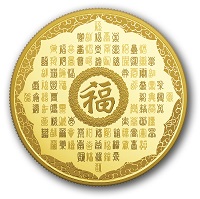
Face value: 30 dollars … Composition: 99.99% Pure Silver;
Mintage: 3,888; Weight: 62.69 g; Diameter: 50 mm;
Finish: Proof with gold plating; Edge: Serrated
Artist: Christopher Reid;
Packaging: Maroon clamshell with black beauty box.
Live healthy, Live happy, Live long, May good fortune come to you and be as boundless as the universe, May good luck and prosperity follow you, May harmony pour into your home, May love and joy fill your heart and your many days. The blessing of good fortune (Fú) is a most auspicious and all-encompassing wish, for it is said that fortune comes to us in many disguises. It may mean peace, health, longevity, wealth, or love—the very things we desire most for our cherished friends and loved ones, and for ourselves too. And, when expressed in 100 different ways, as it is on this fully gold-plated 99.99% pure silver coin, it becomes a beautiful hundredfold blessing that confers all the best wishes on its intended recipient.
Design: Designed by Canadian artist Christopher Reid, your fully gold-plated coin brings together traditional Chinese symbolism and contemporary art elements to visually represent 100 blessings of good fortune. Edged by a laser-engraved pattern, an auspicious lotus shape fills much of the field. The Chinese word for “good fortune,” Fú, is prominently engraved at the centre of the lotus, where it is framed by an ornamental flourish. Ninety-nine other variations of the word Fú, each one different from the other, are symmetrically positioned within the petals to bring harmony and balance to the design. The obverse features the effigy of Her Majesty Queen Elizabeth II by Susanna Blunt.

2019 … $20 Pure Silver Coin –
Canada’s Historical Stamps: Arrival of Cartier – Quebec 1535
www.canadapost.ca www.mint.ca
Our second stamp-shaped tribute to philately! In 1908, the Post Office Department of Canada (now Canada Post) issued the Tercentenary Series of Postal Stamps to commemorate the 300th anniversary of the founding of Quebec City by Samuel de Champlain. The series featured a mix of portraits and vignettes that delved into the region’s rich history — including the 20-cent stamp’s depiction of Jacques Cartier’s arrival in 1535. The classic look of a bygone era. This coin travels back in time to 1908, to reproduce a stamp issued for the 300th anniversary of the founding of Quebec City. Faithful reproduction. The engraved reproduction of the 1908 stamp is just as detailed as the original — complete with horizontal lines that were the product of intaglio printing, or line engraving, one of the oldest methods of stamp production. Vintage colour. The addition of colour over engraving completes this reproduction of the original brown-coloured stamp. Forever preserved in 99.99% pure silver, this collectible is the perfect gift for philatelists and numismatists alike!

Face value: 20 dollars … Composition: 99.99% Pure Silver;
Mintage: 5,000; Weight: 31.86 g; Diameter: 51 mm x 30 mm;
Finish: Proof; Edge: Plain;
Packaging: Maroon clamshell with black beauty box.
The maritime scene on your coin was one of four vignettes featured in Canada’s 1908 Tercentenary Series of Postal Stamps, which included eight denominations: 1/2 cent, 1 cent, 2 cents, 5 cents, 7 cents, 10 cents, 15 cents and the 20-cent stamp reproduced here. A total of 304,200 of the 20-cent stamps were printed by the American Bank Note Company (later the Canadian Bank Note Company) in Ottawa, Ont., all in sheets of 100 stamps, before their release on July 16, 1908.
Design: Engraved on the stamp-shaped reverse is a detailed reproduction of a Canadian postage stamp issued on July 16, 1908, to commemorate the 300th anniversary of the founding of Quebec City by French explorer and navigator, Samuel de Champlain. The stamp was titled “ARRIVÉE DE CARTIER – QUÉBEC 1535” (Arrival of Cartier – Quebec 1535), as inscribed beneath the image. It was designed by José Antonio Machado and originally engraved by Elie Timothée Loizeaux, as evidenced by the horizontal lines that are indicative of traditional intaglio printing or line engraving. The image depicts the arrival of Champlain’s predecessor, French explorer Jacques Cartier, in the St. Lawrence River near the Iroquoian village of Stadacona. An application of modern colour mimics the brown colour of the original issue, while the double dates “1608” and “1908” and the words “IIIE CENTENAIRE DE QUÉBEC” reflect the city’s tercentenary. Like the 1908 stamp, your coin also includes ornamental flourishes and the words “CANADA POSTAGE” atop the framed image, while the stamp’s original denomination is represented by the number “20”. The obverse features the effigy of Her Majesty Queen Elizabeth II by Susanna Blunt.
Did you know… * The original design’s horizontal lines were the product of intaglio printing and an early security feature, since the raised ink effect was more difficult to replicate. * The three ships are those of Cartier’s second voyage (1535-1536): Grande Hermine, Petite Hermine, and Emerillon.

2019 … $20 Pure Silver Coloured Coin – Canada’s Historical Stamps:
Coat of Arms and Flags Special Delivery
www.canadapost.ca www.mint.ca
Beyond history-themed pictorials and portraits, Canada’s philatelic history can also provide a sense of the nation’s mindset at a key moment in time. Such is the case with this uniquely shaped reproduction of a vintage stamp, which is forever preserved in 99.99% pure silver. The third (and final) installment in our limited tribute to philately, your stamp-shaped coin takes a special look at Canada in 1942—a time when a proud nation had dedicated its resources to support an Allied victory in the Second World War.

Face value: 20 dollars … Composition: 99.99% pure silver;
Mintage: 5,000; Finish: proof; Weight: 31.86 g;
Diameter: 51 x 30 mm; Edge:
Certificate: serialized; Artist: Susanna Blunt (obverse).
Design: Engraved on your stamp-shaped coin is a detailed reproduction of a Canadian special delivery stamp issued on July 1, 1942, to highlight Canada’s involvement in the Allied cause during the Second World War. The 10-cent denomination stamp was designed by Herman Herbert Schwartz and originally engraved by Silas Robert Allen, as evidenced by the horizontal lines that are indicative of traditional intaglio printing or line engraving. The pictorial collage features the former Arms of Canada within a shield atop a bough of maple leaves, and flanked by four flags that represent Canada’s different military contributions. An application of modern colour mimics the deep bright green colour of the original issue, which had an inscribed denomination of “10 CENTS”. The obverse features the effigy of Her Majesty Queen Elizabeth II by Susanna Blunt.
The 1942-43 War Effort Issue … On July 1, 1942, the Post Office Department of Canada introduced the War issue: a series of patriotic-themed stamps that highlighted the nation’s contributions to the Allied war effort, both at home and abroad. The special delivery stamp re-created on the coin’s reverse features a collage of emblematic images that reflect pride in Canada’s military contributions—from the flag of the Royal Canadian Air Force to the stylized version of the Arms of Canada. By the fall of 1946, 3,276,404 of these stamps had been printed at the Canadian Bank Note Company’s facility in Ottawa where some of Canada’s postage stamps are still produced today.
Did you know… *Issued between 1898 and 1946, Canada’s special delivery stamps were used for express mail delivery (similar to Canada Post’s Xpresspost today). *Canada’s final special delivery stamp (1946) was a peacetime version of this design. It featured a different-shaped shield, while laurel boughs replaced the flags.



The GTAPA is committed to promote and stimulate the art of philately
to all ages for fun, culture, education, and friendship.


Royal *2019* Royale
www.rpsc.org/royal2019
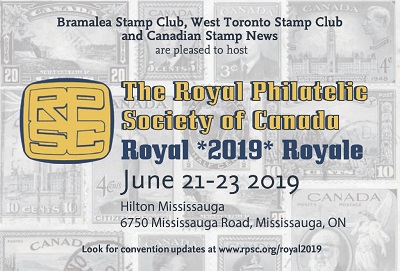
The West Toronto Stamp Club, Bramalea Stamp Club, and Canadian Stamp News are co-hosting Royal *2019* Royale. The June 21-23 convention will be held at the classy Hilton Mississauga on 6750 Mississauga Road. The next annual general meeting (AGM) of The Royal Philatelic Society of Canada (RPSC) will be held on the morning of June 22 during the society’s 91st convention in Mississauga, Ontario. The aim of the AGM, which will be held at the Hilton Mississauga/Meadowvale, is for members to receive and consider reports from executive members, directors and duty officers as well as the society’s financial statements as of Dec. 31. Members will also consider – and if approved, ratify, sanction and confirm – all by-laws, contracts, acts, and proceedings of The RPSC’s board of directors enacted since the last AGM. There will also be an election of seven directors. The 2019 election of director positions will be decided by secret ballots submitted by members of the society.






